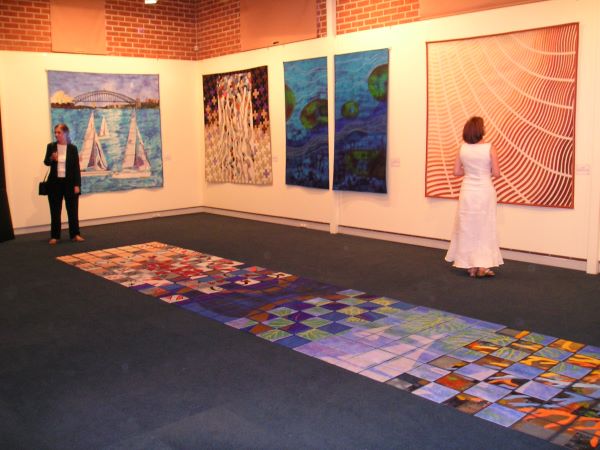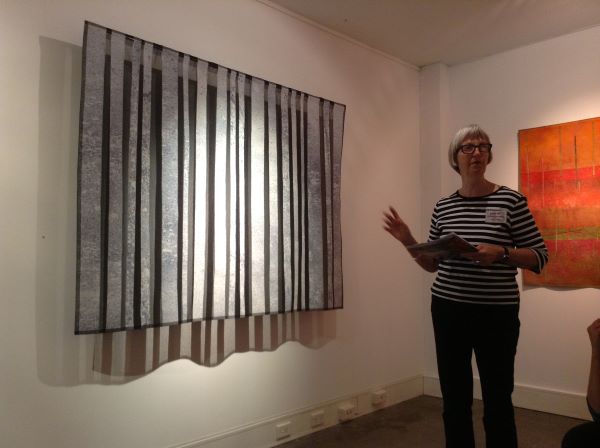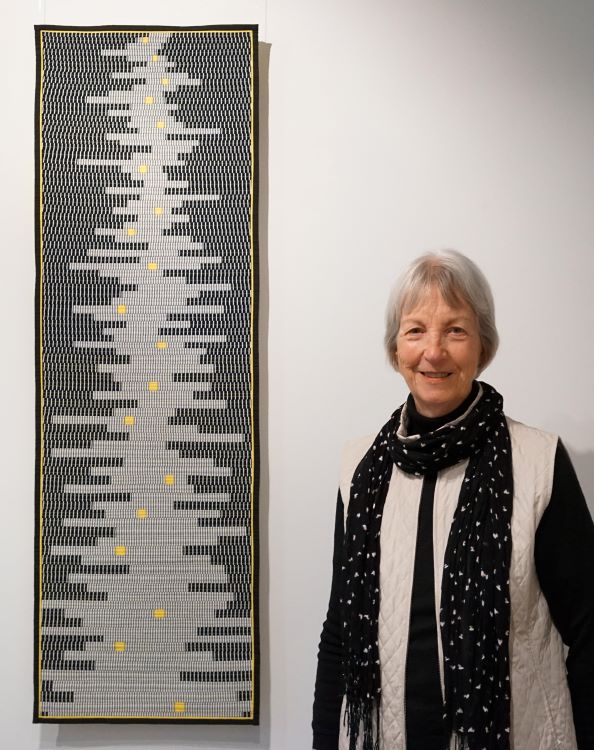SAQA Seminar - Unit 1
Artist Q&A Dianne Firth - Exhibiting Your Art
How did you get started making and exhibiting art quilts?
I grew up as the youngest of four children in a working class family in the industrial city of Newcastle in Australia. Dad was a fitter and turner, and Mum was a milliner but gave up paid work when she married. We were a family of designers and makers and always happy to show what we made, particularly in the local community shows. It was always great to see what won the ribbons. Sometimes we won, other times not, but either way it encouraged us to keep making. This was the beginning of my enjoyment in exhibiting.
When I was very young I broke our Singer treadle sewing machine by trying to sew thin sheets of metal together to make a Joan of Arc suit of armour – she was my hero. As a consequence my father bought me an electric sewing machine on the condition that I only sewed fabric. I loved using my sewing machine and always sewed my own clothes, mostly from purchased patterns. I also made domestic items like bed covers and cushions with left-over or recycled fabrics – well before I knew anything about quilting.
Unlike my older sisters, but like my brother, I had the opportunity to go to university. I studied Science, majoring in mathematics and chemistry, but I also attended night school to learn pattern making and textile manipulation. This meant I could design and make my own clothes without patterns. It was also the time when Scandinavian design arrived in Australia. Using my own patterns, I made a range of clothes with Marimekko fabrics to sell at the local store. But I had to abandon this venture as it was interrupting my university studies too much.
After I finished university, I married my long-time boyfriend and started teaching high school mathematics. He was an architect and to undertake further studies we moved to Glasgow, Scotland, for 3 years. While he studied I taught at a high school a block away from the Glasgow Art School. The Art School had an amazing collection of textiles, and I started taking night classes there. Over our time living and travelling in Europe, I visited many museums and galleries and saw collections of layered stitched textiles including quilted clothes and quilts for beds. Also on our travels to see European architecture, I was more impressed by the designed landscapes and gardens around them than the buildings.
When we returned to Australia in the early 1970s to make our home in Canberra, I made quilts for our beds and quilted clothing for our growing family. It was also the time when American quilting ideas were filtering into Australia. Through friends at my children’s schools I joined a weekly sewing group, made charity quilts, and organised quilt related projects at the schools. Quilting groups were being set up, and I joined the Quilters Guild of NSW and then Canberra Quilters. I started showing quilts through their annual exhibitions. This was the beginning of my quilt exhibiting journey.
.jpg)
1992 Canberra Quilters Exhibition
We lived in a city beautified by landscape, I was a keen gardener with an interest in horticulture, and I loved the uniqueness of the Australian bush. I also loved drawing and imagining new possibilities for ideas. So in the late 1970s, despite our growing family, I decided to give up high school teaching, go back to university, and retrain as a landscape architect.
After completing my degree, I practiced for a couple of years to gain the required registration, then set up business. However, my love of teaching didn’t go away and I returned to the university part-time to tutor, run studios, and eventually become a lecturer. Although I continued to practice as a landscape architect, I moved into academia with vigour. I enjoyed research and found it an amazing source of ideas that could be explored through quilt art.
But where would I show this work? Many faculty colleagues were also creative artists, so along with another colleague, I set up an annual staff art exhibition to show what we made in a research context. This gave me an opportunity to write about the ideas that were the basis of many of my art quilts. Our first exhibition was held in a disused technical workshop which we cleaned up and over the years painted, installed lighting, and covered the concrete floor. Several colleagues were anxious that the students would be critiquing their work when it was usually the other way around. However, the overall experience was positive and most of the students loved seeing another side to their lecturers. This staff exhibition is now in its 25th year.
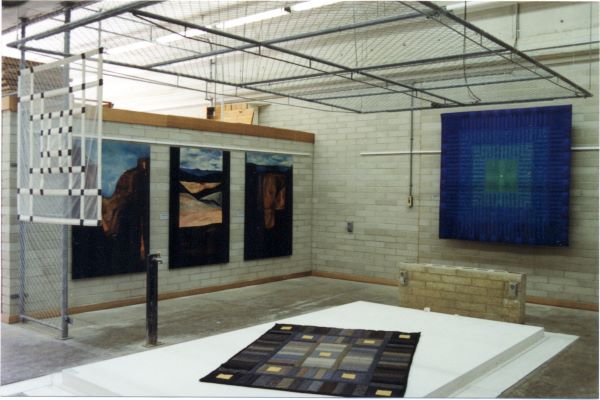
1995 Staff Exhibition
I had sometimes felt a bit outside the normal quilt fraternity because of my work and family commitments. Many of my friends had dedicated studios and seemed to have more time to create. My quilting work was done after hours, on the dining room table after dinner, then packed away for the morning. As a result, I developed techniques that would allow me to work this way. I found that doing something nearly every day in a consistent manner enabled me to be quite productive. Sometimes it might be work that I wanted to enter into an exhibition, but other times it was just to test an idea or to have fun. And it always meant that I had something to show.
In the late 1990s, I attended a masterclass by visiting American quilter Nancy Crow. She discussed the importance of exhibiting and suggested some opportunities for exhibiting globally. Nancy was very encouraging and following her workshop the group, which is called the Experimentalists, continued to meet every three months to discuss art inspirations, our current work, engage in experimental challenges, and occasionally exhibit together.
On several occasions I have been approached by people who have been organising exhibitions where someone has dropped out. I usually say yes when invited and then work out a way to do it. An interest in using exhibition to explore opportunities for our art quilting was shared by a few of my Canberra friends and together we formed the tACTile group. We were looking for ways to expand our work and started putting together themed exhibitions every two years that would travel to Australian galleries. From 2003-2017 we found venues, made large work that included some aspect of collaboration, set up a website, coordinated information, and sent the work off to galleries around Australia. Not only did the five artists of tACTile make work to fill a standard gallery space, we curated and managed it. Eventually we ran out of steam. We may exhibit in the future, but in a less ambitious manner.
2003 tACTile Pathways Exhibition
An Australia-wide interest in art quilts was recognised in the 1990s by the creation of a newsletter, originally circulated by snail mail to its members. Called Ozquilt Network, it shared information relevant to art quilters and those interested in art quilts. Now, with the monthly newsletter in digital form, Ozquilt Network also mounts biennial non-themed juried art quilt exhibitions that are held in galleries for an extended period of time. They are open to all artists. On alternate years, a selected members’ only travelling exhibition is held.
I have volunteered to be part of the organising committee for these exhibitions since 2009, and I both contribute my knowledge on exhibitions and continue to learn new things about organising and curating exhibitions. To avoid a conflict of interest and still be eligible to submit an entry, we have developed a method of blind selection by an external panel of three experts with quilt/art/curatorial expertise. They are responsible for selecting the works for the exhibition.
2013 Art Quilt Australia Exhibition
I have found further opportunities for exhibiting by becoming a member of Craft ACT and submitting work for their members’ exhibition each year. I also respond to calls for entry to mixed art and craft exhibitions when it is clear that textiles are accepted. I find this broadens my perspective and introduces a different audience to see my work. Sometimes these exhibitions have themes, sometimes they are open.
2019 Craft ACT Members Exhibition
SAQA membership has also provided opportunities for exhibiting overseas, and now in Australia. Most of the Australian state guilds also run dedicated art quilt juried exhibitions separate from their normal guild shows, and I try to submit entries to these exhibitions. (The New Quilt, Dare to Differ, One Step Further, Australian Quilts in Public Places)
Tell us about your success being juried into international exhibitions.
Until 2000, most of my exhibiting was with guild shows or juried exhibitions in Australia. I did, however, have the opportunity to have work selected for an exhibition that a quilter was taking to Europe in her suitcase. I never knew if I would see the work again, but I weighed up the benefit of getting my work out there with other quilters whose work I admired. Despite this overseas opportunity, I was never particularly systematic about searching for international exhibitions by myself. I just seemed to tag along.
That has changed over time. Now I consider who is running it, the status of the exhibition, the quality and reputation of the venue, length of time of the exhibition, whether it will be professionally hung, insurance covered, overall cost to me, and whether there is a catalogue or not. I regard hard copy catalogues as important to the long term record of the exhibition. This is because digital records can often disappear.
I only seriously began to consider international exhibitions when I saw a call for entries in my local sewing machine shop in 1999. It was by Husqvarna Viking for Quilt Expo VII 2000 in Strasbourg, France. The exhibition would then travel to other venues. The theme was Keeping the World Sewing and the quilt was to be 130cm x 130cm. I made the work, had it professionally photographed, and sent the paperwork and slides off to Sweden by snail mail. I was thrilled to have my work accepted. Through all of this I had not really considered costs of photography and overseas postage, which were quite significant. Customs regulations and insurance also became issues. I was only able to manage the costs because I had another income.
Exhibiting overseas was a new adventure and I started submitted entries to Quilt National, then Art Quilt Elements, and now SAQA exhibitions.
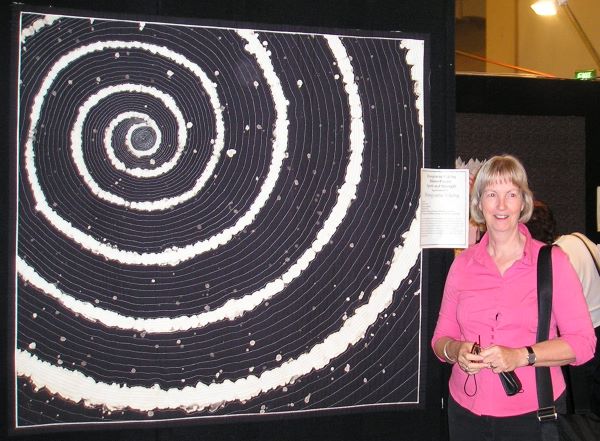
2003 Husqvarna Spirit and Strength Exhibition
When sending quilts to exhibitions overseas, customs and insurance need to be considered.
There is much more information available now because of the Internet, and I give more consideration to the entries I submit. It also depends on whether it is a themed exhibition or an open one.
Do you exhibit your artwork in non-art venues?
I have exhibited in libraries, craft shops, church halls, schools, coffee shops and restaurants. These venues are usually good for sales but they aren’t really useful in presenting my work as a serious artist. I prefer not to exhibit at food venues as textiles can absorb smells.
Tell us about your solo exhibition inspired by poetry.
When I retired as Head of Landscape Architecture at the University of Canberra, I remained as an adjunct member of staff in the Centre for Creative and Cultural Research (CCCR). I mostly supervise research students, give occasional lectures, and run guest studios. The Centre also includes creative writers and poets and runs an international poetry festival each year. When I was listening to some of the poetry readings, I started to see shapes, colour, and movement. I asked some of the visiting poets if they would write me poems about their reaction to the Canberra landscape and environment. I asked if I could use their poems as inspiration for my textile art, explaining that I would show it at the Poetry on the Move festival the following year.
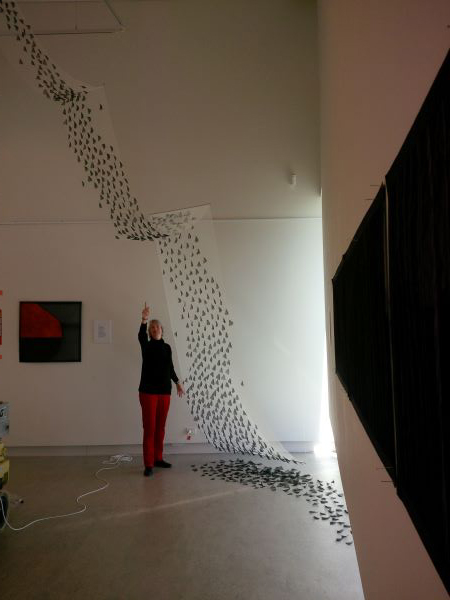
2017 Solo Exhibition Poetry and Place
Challenges included:
- Developing a strong concept and proposal
- Presenting the proposal to galleries (and finding that some galleries require 2-3 years notice)
- Securing a suitable gallery space (signing the contract)
- Developing a business plan
- Applying for grants
- Making the work (less than 12 months to fill a large gallery space – no pressure!)
- Photographing the work
- Liaising with the gallery curator (who does what, graphics, establishing sales prices, etc.)
- Producing a catalogue book with images and poems
- Organising a speaker for the opening and other activities over the exhibition period
- Overseeing the hanging of the work
- Liaising with the media
- Being the star at the opening
- Being available for follow up activities over the period of the exhibition, such as poetry readings beside the artwork, school visits, concerts of music in the space, etc.
- Taking down the exhibition
- Concluding all business (took a long time)
Your work will be included in the Tamworth Fibre Textile Biennial. What is that like?
Last year I submitted an expression of interest to be considered for the Tamworth Fibre Textile Biennial. Tamworth Art Gallery is a regional art gallery in NSW Australia that specialises in textiles. The exhibition showcases innovative fibre textile works in a curated exhibition and is recognised nationally as Australia’s pre-eminent textile exhibition. After opening in Tamworth it travels to major galleries around Australia for two years.
I was one of 18 artists selected from around Australia. We were invited to Tamworth over a weekend to meet with the curator and the other artists, to see the gallery space, and to discuss ideas for our new work. This is very exciting, but also challenging as I will be the only quilter.
How do you respond to disaster?
There have been two disasters I would like to mention:
1. In the early 1970s, before we had shops selling quilting materials, I made a quilt for my new baby. I decided to use a thin flexible foam rubber that was readily available. It was a disaster as after several washes the foam started to disintegrate. However, I asked around and discovered the right product was becoming available. I pulled the quilt apart and remade it with wadding that could stand vigorous machine washing.
2. My second disaster was making a commissioned quilt to the wrong size. It was a particularly busy time at work, and I was rushing to finish the project before I headed to Europe for a conference. It did not need to be delivered until after I returned. Once I was back I had it photographed and as I was recording the dimensions realised I had made it 20cm (8”) too long. What was I to do? I could cut off the extra 20cm, but then the composition would be wrong. So I decided to start afresh and made another quilt to the correct size. Fortunately I had enough fabric and I streamlined the process, but it was not made with the same love or enjoyment as the first one.
Why is good photography important for promoting your work?
Good photography is essential if you are submitting an entry where selection is by image. Read the required specifications carefully. It is also good to have a high-resolution image so that it can be used for publication. You can always resize images smaller, but you can’t make them larger.
I don’t have a good camera or a space with the correct lighting, so I mostly use professional photographers. Not all photographers photograph textiles well, and I tried several before I found the right one at a reasonable price. You need to be able to explain what you need and always allow enough time as photographers are also busy people. Speak to other artists and ask them how they go about getting good photographs.
Any other words of advice?
There are different types of exhibitions and they have different purposes. Some run for a few days, others for weeks or months. Some are in exhibition sheds, others in dedicated galleries. Some are run by volunteers, some by gallery exhibition officers. Visit quilt exhibitions and also art and craft exhibitions. See where your work might fit.
If you want to exhibit, my advice is to jump in and just start exhibiting. If you have something to show, then show it. However, you might also like to ask yourself why you want to exhibit and what you hope to gain from exhibiting. And would you want to make new work or be able to show work you have already made.
Keep a record of every exhibition you enter and take candid photos of your work in the exhibition setting. Be curious and try to see how it all works. The people who mount good exhibitions usually have a range of skills and you might like to learn some of them. Try volunteering, do your research, share, and network.
I suggest you start exhibiting with open group shows, such as guild shows. The first time might be a bit intimidating, but it is also a time to take pride in your creative achievement and share it with the other artists. Most people will say nice things about your work, but try to stand apart and assess it yourself – not against others’ work, but against what you were trying to achieve. Be able to tell the story behind your work. Most people are interested in the story, not just the technique. Over time you will develop your confidence – and your resume.
If you are entering your work into a juried exhibition, make sure you read the conditions of entry carefully. For some exhibitions there may be constraints on the work such as it being new work, no more than 2 years old, or work that has not been exhibited before. Be prepared for rejections, and if you get one, develop a thick skin as rejections can hurt. Realise that a rejection only means the selectors had different priorities. Consider entering your work into other art and craft exhibitions.
Selling your work at exhibitions needs to be thought through too. Galleries will take their commission, sometimes up to 50%, and work will not be available to the buyer until after the exhibition.
If you have the opportunity, learn what you can about how exhibitions are put together - and mount your own exhibition.


